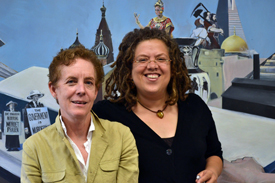Seminar examines how ideas about race are closely linked to location
 Bay, director of the Rutgers Center for Race and Ethnicity, didn’t think much of her mother's story, until she began researching her upcoming book about segregated transportation in the United States. “No one ever talks about segregation on planes, but I found there was a secret code used to make sure that all black people sat in the same row,’’ she says. For Bay, the little known history of airline segregation illustrates the ways in which definitions of race, and the experiences of racial minorities, have differed from place to place – whether it’s a city block, a railroad car, or an airplane. 'America’s racial maps have always been complex and contradictory, subject to changing laws and shifting borders. ' -- Ann Fabian
“Who is black and who is white is decided by different calculations, in different places; as is who is Indian and who is not,’’ says Bay, a professor of history in the School of Arts and Sciences (SAS) “The racial classification of many ethnic groups changes over time; and some societies adopt multiracial categories, while others do not.’’ How location shapes ideas about race, and vice versa, are questions Bay and Ann Fabian, a professor of History and American studies in SAS, will explore in a yearlong seminar next year, “Race, Space and Place in the Americas.’’ They received a $175,000 Sawyer Seminar grant for comparative research from the Andrew W. Mellon Foundation for the project, which will convene scholars from different disciplines for a year-long series of lectures and events. The foundation invites only a few universities a year to compete for seminar funding, and although Rutgers was invited a few years ago, this is first year the university was awarded a grant. According to the Mellon foundation, the seminars are “temporary research centers,’’ where academics from Rutgers and elsewhere can pool information that might not be shared if they were working strictly within their departments or institutions. Bay and Fabian will work with academics from Rutgers and neighboring universities. “It will let us bring in people who approach the problem of race and space from different angles: anthropology history and geography. It’s an investigation, a work in progress,’’ says Fabian. “The seminar gives us a chance to explore the new scholarship that captures the experiences of many groups of people.’’ For Bay and Fabian, the “racialization’’ of place can range from the role of geographic boundaries, such as the Mason-Dixon line, to a place as small as a Korean pizza parlor in a strip mall. “America’s racial maps have always been complex and contradictory, subject to changing laws and shifting borders,’’ says Fabian. The “Race, Space and Place’’ project will compare different regions in the Americas, including Mexico, where nationality supersedes racial identity for the country’s many ethnic groups, and Brazil, a multiracial society where miscegenation was never outlawed as it was in the U.S. It will compare how race is viewed in South and Central America, in addition to various parts of the U.S. and North America. Bay will share some of her research on segregated transportation. In the southern U.S., railroad cars were among the first public places to be segregated when slavery was abolished, although trains were segregated in parts of the north before the war. Since slaves weren’t allowed to travel freely, there was no need for segregated trains in the Pre-Civil War south, Bay explains. Before segregation, railroad cars were divided into “smoking cars,’’ where men congregated, and “ladies'' cars, for women and families, Bay explains. But after segregation blacks were forced to sit in what used to be the smoking cars. Conductors enforced segregation laws, often streering Asians or Native Americans into the colored cars as well. Sometimes, irate white passengers would be misidentified as black and barred from the whites-only cars. “Sometimes they would sue and they almost always got damages,’’ says Bay. The seminar will also examine new research on Japanese internment camps. After the bombing of Pearl Harbor, the U.S. government rounded up people of Japanese descent, many of them American citizens, because officials were worried about sabotage. U.S. allies in Central and South America did the same. Bay and Fabian hope to explore the ethnic and racial communities disrupted by such dislocations and the way they were rebuilt. Fabian became interested in issues of race and place while writing The Skull Collectors (University of Chicago Press 2010). The book focuses on 19th-century scientist Samuel George Morton, who procured more than 1,500 skulls and used them to assert the superiority of Caucasians in his influential book Crania Americana, frequently cited today as the blueprint for “scientific racism.’’ Most of the skulls he was able to collect were those of Native Americans, often members of tribes who were being forced off ancestral home lands. No laws protected Indian burial grounds. “(It) made me recognize that there was a spatial dimension to even this old history . . . and that digging up the dead was one way of denying Native Americans a right to a place in the American landscape,’’ Fabian says. In the seminar, Bay and Fabian hope to shed light on the overlooked history surrounding events like these. “We live in a highly segregated society where race and geography still often go hand in hand,’’ says Bay. “We see the current racial and ethnic categories as the norm. As a result, we tend to barely see the social, political, and economic factors that organize and perpetuate these divisions, and sometimes foster new ones.’’
|